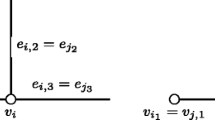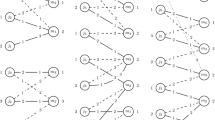Abstract
It is well known that the one-sided stable matching problem (“stable roommates problem”) does not necessarily have a solution. We had found that, for the independent, uniformly random preference lists, the expected number of solutions converges to \(e^{1/2}\) as n, the number of members, grows, and with Rob Irving we proved that the limiting probability of solvability is below \(e^{1/2}/2\), at most. Stephan Mertens’s extensive numerics compelled him to conjecture that this probability is of order \(n^{-1/4}\). Jimmy Tan introduced a notion of a stable cyclic partition, and proved existence of such a partition for every system of members’ preferences, discovering that presence of odd cycles in a stable partition is equivalent to absence of a stable matching. In this paper we show that the expected number of stable partitions with odd cycles grows as \(n^{1/4}\). However the standard deviation of that number is of order \(n^{3/8}\gg n^{1/4}\), i.e. too large to conclude that the odd cycles exist with probability \(1-o(1)\). Still, as a byproduct, we show that with probability \(1-o(1)\) the fraction of members with more than one stable “predecessor” is of order \(n^{-1/2+o(1)}\). Furthermore, with probability \(1-o(1)\) the average rank of a predecessor in every stable partition is of order \(n^{1/2}\). The likely size of the largest stable matching is \(n/2-O(n^{1/4+o(1)})\), and the likely number of pairs of unmatched members blocking the optimal complete matching is \(O(n^{3/4+o(1)})\).
Similar content being viewed by others
References
Abraham DJ, Biró P, Manlove DF (2006) “Almost stable” matchings in the roommates problem. In: Proceedings of WAOA ’05: the 3rd workshop on approximation and online algorithms, lecture notes in computer science, 3879:1–14
Alcalde J (1995) Exchange-proofness or divorce proofness? Stability in one-sided matching markets. Econ Des 1:275–287
Andrews GE, Askey R, Roy R (1999) Special functions. Cambridge University Press, Cambridge
Bóna M (2004) Combinatorics of Permutations. Chapman & Hall/CRC, Boca Raton
Cechlárová K, Manlove DF (2005) The exchange-stable marriage problem. Disc Appl Math 152:109–122
Chernoff H (1952) A measure of asymptotic efficiency for tests of a hypothesis based on the sum of observations. Ann Math Stat 23:493–509
Flajolet P, Sedgewick R (2009) Analytic combinatorics. Cambridge University Press, Cambridge
Frieze A, Pittel B (1996) Probabilistic analysis of an algorithm in the theory of markets in indivisible goods. Ann Appl Probab 5:768–808
Gusfield D, Irving RW (1989) The stable marriage problem, structure and algorithms. The MIT Press, Cambridge
Irving RW, Pittel B (1994) An upper bound for the solvability probability of a random stable roommates instance. Random Struct Algorithm 5:465–486
Karlin S, Taylor HM (1981) A second course in stochastic processes. Academic Press, Cambridge
Knuth DE, Motwani R, Pittel B (1991) Stable husbands. Random Struct Algorithms 1:1–14
Knuth DE (1996) Stable marriage and its relation to other combinatorial problems: an introduction to the mathematical analysis of algorithms. In: CRM proceedings and lecture notes
Knuth DE (1996) An exact analysis of stable allocation. J Algorithm 20:431–442
Manlove DF (2013) Algorithmics of matching under preferences. World Scientific, Singapore
Mertens S (2005) Random stable matchings. J Stat Mech Theory Exp 10:P10008
Pittel B (1989) The average number of stable matchings. SIAM J Disc Math 2:530–549
Pittel B (1993) On a random instance of a “stable roommates” problem: likely behavior of the proposal algorithm. Comb Probab Comput 2:53–92
Pittel B (1993) The “stable roommates” problem with random preferences. Ann Probab 21:1441–1477
Shapley L, Scarf H (1974) On cores and indivisibility. J Math Econom 1:23–37
Tan JJM (1991) A necessary and sufficient condition for the existence of a complete stable matching. J Algorithm 12:1–25
Tan JJM (1991) Stable matchings and stable partitions. Int J Comput Math 39:11–20
Acknowledgements
Almost thirty years ago Don Knuth introduced me to his ground-breaking work on random stable marriages. Don’s ideas and techniques have been a source of inspiration for me ever since. The masterful book by Dan Gusfield and Rob Irving (1989) encouraged me to continue working on stable matchings. I am very grateful to Rob for the chance to work with him on the stable roommates problem back in 1994, and for his encouragement these last months. Itai Ashlagi, Peter Biró, Jennifer Chayes, Gil Kalai, Yash Kanoria, Jacob Leshno and the recent, encyclopedic, monograph by David Manlove made me aware of a significant progress in theory and applications of two/one–sided stable matchings. I thank the organizers for a valuable opportunity to participate in MATCH-UP 2017 Conference. Finally it is my genuine pleasure to thank the hard-working referees for providing me with meticulous lists of critical comments and constructive suggestions. I am grateful to the Editors for the efficient refereeing process.
Author information
Authors and Affiliations
Corresponding author
Appendix
Appendix
Proof of Lemma 5.3
We already observed, (5.8), that \(\sum _i (x_i\vee y_i)=\sum _j\xi _j\). So, similarly to (5.9)–(5.10) we have:
(Relaxing the constraint on s to \(s\ge 0\) we get back to (5.10)). The last integrand attains its maximum at
which is below \(s_n-3\log n\) if \(k\le m_n\). Let \(S_{\le m_n}\) and \(S_{>m_n}\) denote the sub-sums of the sum above, for \(k\le m_n\) and \(k>m_n\) respectively. Then, expanding integration to \([0,\infty )\), we obtain
since \(\nu \le m_n\), the ratio of the consecutive terms in the sum is below 2 / 3. Droping \([(\nu -1)!]^2\) in the denominator and using the Stirling formula for the other factorials, we simplify the bound to
The bound is smaller than the bound (5.11) for the full sum of \(s(n+m,\nu ,k)\) by the factor \((n+m)^{m_n}\). Turn to \(S_{\le m_n}\). This time the bottom integral over \(s\ge s_n\) in (6.1) is small, compared to the integral over all \(s\ge 0\), because for \(k\le m_n\) the maximum point of the integrand is at distance \(3\log n\), at least, from the interval \([s_n,\infty )\). More precisely, using the argument in the proof of Lemma 4.5, we have
Therefore
Combining (6.2), (6.3) and (5.11) we transform the inequality (6.1) into
So, like the part (1) in the proof of Lemma 5.1, we obtain
\(\square \)
Proof of Lemma 5.4
Introduce \(L_1',\dots ,L_{n+2\nu }'\), the intervals lengths in the random partition of [0, 1] by the \(n+2\nu -1\) random points. Analogously to (5.9), but using the sharper inequality in Lemma 3.1, (3.1), we have: with \(s:=\xi _1+\xi _2+\xi _3=\sum _{i\in [n]}x_i'+\sum _{i\in A\cup B}y_i'\) (see (5.5) and (5.6)),
Arguing as in (4.12), the expectation factor is less than
The integral is less than
Here the double integral equals
So
Therefore
The summand \(s'(n,m,\nu ,k)\) is similar to the summand \(s(n+m,\nu ,k)\) defined in (5.10). Closely following the derivation of the bound for \(\sum _{k\ge 0}s(n,\nu ,k)\) in Pittel (1993b), we obtain
compare to (5.11). The last two bounds complete the proof. \(\square \)
Rights and permissions
About this article
Cite this article
Pittel, B. On random stable partitions. Int J Game Theory 48, 433–480 (2019). https://doi.org/10.1007/s00182-018-0635-9
Accepted:
Published:
Issue Date:
DOI: https://doi.org/10.1007/s00182-018-0635-9




